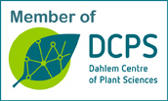Short history of the Applied Genetics of the FU Berlin
The Applied Genetics belonging to the Institute of Biology of the Free University Berlin in Dahlem can look back on a history full of changes. The so-called old building was built in 1922/1923 to host the Institute of Heredity Research of the Royal Prussian Agricultural University. The university moved in 1925 from the center of Berlin to the then still rural Dahlem. The Institute of Heredity Research had been founded in 1914 by Erwin Baur, one of the pioneers of genetics and one of the leading geneticists of his time. It was the first institute in Germany where the knowledge about genetics was systematically applied to agriculture.
The sucessor of Erwin Baur, Hans Kappert, led the institute from 1930 to 1957 and was active in teaching heredity and breeding research. Hans Kappert, a disciple of Carl Correns, connected fundamental research with practical breeding. His favourite reseach object was Matthiola incana. The transmission of some of theMatthiola marker genes discovered in Kappert's days is still a subject in our practical course. In 1932 the institute became part of the Berlin University. After the division of Berlin it belonged still to the East-Berlin Humboldt University, despite being on western ground. In 1951 a small "student's revolution" caused the agricultural institutes in Dahlem to become parts of the Technical University of Berlin.
From 1958 to 1974 Walther Hoffmann led the institute. During his era extensive research programs to generate not only novel cultivars of barley and red radish but also novel combinations of rapeseed and wheat genomes were conducted. In 1972 the members of the institute voted to become part of the Free University of Berlin and to teach applied genetics. From 1974 to 1989 the institute was led by a board of directors which consisted of professors, scientific and non-scientific members, and students. From 1989 to 1998 Otto Schieder, who was appointed for the area of somatic cell genetics, led the institute. With this new topic hybrid cells and genetic transformation were introduced as novel methods of plant breeding. To serve the needs of the new techniques a new building was opened as a modern laboratory building in 1990. In 2001 Thomas Schmülling coming from the Center of Plant Molecular Biology (ZMBP) in Tübingen was appointed as the successor of Otto Schieder. With the establishment of the new professorship of Molecular Developmental Biology of Plants, the institute became more oriented towards basic research. This development was continued with the appointment of Reinhard Kunze as a professor for Molecular Genetics of Plants.
These informations were cited from the essay "The history of the Institute of Applied Genetics of the FU" by Prof. G. Linnert in the festivity brochure "75 years Institute of Applied Genetics" (Berlin 1990). Translation by W. Brenner.


